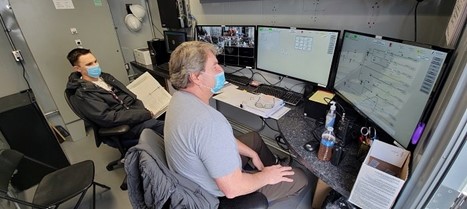The interior of JET with a superimposed plasma. (Image: EUROfusion)
A new record has been set by the world’s largest operating tokamak, the Joint European Torus (JET). According to the EUROfusion scientists and engineers who work on JET at the U.K. Atomic Energy Authority’s Culham Centre for Fusion Energy, the landmark experiment, announced on February 9, which produced 59 megajoules of fusion energy over five seconds, is powerful proof of fusion’s potential as a clean energy source.
The first steel ring section of the Unit 2 reactor building was installed in November 2021. (Photo: EDF Energy)
The United Kingdom’s Office for Nuclear Regulation (ONR) has granted permission for the start of bulk mechanical, electrical, and HVAC component installation work at the Hinkley Point C site in Somerset, England, where two 1,630-MWe EPRs are under construction. Thus far, most of the activity at Hinkley Point C has been in the field of civil construction.
This new phase, according to ONR, will require a workforce of up to 4,000 during peak times, including welders, pipe fitters, and electricians. The work is to be accomplished over a three-year period, with NNB Genco—the EDF Energy subsidiary set up in 2009 to build and operate Hinkley Point C—teaming up with four suppliers: Balfour Beatty Bailey, Doosan, Cavendish, and Altrad.
A rendering of Holtec International's interim spent fuel repository. (Image: Holtec International)
An article published on the Carlsbad Current-Argus news site on February 5 presents the wide gap between lawmakers in New Mexico on either side of the issue of temporary storage of spent nuclear fuel in the state.
The article noted that two identical bills—Senate Bill 54 and House Bill 127, which advanced in legislative committees last week—would block a spent fuel storage facility in New Mexico by prohibiting state agencies from issuing permits for such a facility.
The MARVEL microreactor prototype in the INL machine shop. (Photo: DOE)
A full-scale, electrically heated prototype for the Department of Energy’s Microreactor Applications Research Validation and Evaluation (MARVEL) project was fabricated in just nine months, according to an article published by Idaho National Laboratory on January 31. The article explains in part how a team from the lab’s machine shop created the prototype.
IAEA director general Rafael Mariano Grossi (left) and WHO director general Tedros Adhanom Ghebreyesus. (Photo: IAEA)
The International Atomic Energy Agency has launched the Rays of Hope program to tackle a severe shortage of cancer care capacity in poorer countries. The program’s initial focus will be on Africa, where people often die from the disease because of the lack of access to potentially life-saving nuclear medicine and radiotherapy, according to the IAEA.
A video on the program is available on YouTube.
The Moab cleanup site in Utah in 2018. (Photo: DOE)
The Department of Energy’s Office of Environmental Management (DOE-EM) has awarded a cleanup contract to North Wind Portage, Inc. for completion of environmental remediation of a uranium ore processing site near Moab, Utah. North Wind Portage is located in Idaho Falls, Idaho.
More information about the Moab project is available here.
SHINE’s Mo-99 production facility under construction in Janesville, Wis. (Photo: SHINE)
SHINE Europe, a nascent subsidiary of Wisconsin-based SHINE Technologies, announced Wednesday that it has secured funding to begin designing an advanced medical isotopes facility in Veendam, the Netherlands. The new facility will use the same fusion-based neutron generator system SHINE is employing at its Janesville, Wis., facility to produce medical isotopes, including molybdenum-99, which is used in diagnostic imaging.
WRPS operations engineer Steven Porter, left, and nuclear chemical operator Brent Walker monitor the TSCR System in the control room as the system is put in operations mode. (Photo: DOE)
The Department of Energy announced on Wednesday that the first large-scale treatment of radioactive and chemical waste from underground tanks at the Hanford Site near Richland, Wash., has begun with the start of operations of the Tank-Side Cesium Removal (TSCR) System.
The newly operational TSCR System removes radioactive cesium and solids from the tank waste. The treated waste will be fed directly to the nearby Waste Treatment and Immobilization Plant (WTP) for vitrification when the plant comes on line next year.



 Today’s #ThrowbackThursday post looks at the initial debate surrounding the conversion of research reactor fuel from high-enriched uranium to low-enriched uranium. An article published in the
Today’s #ThrowbackThursday post looks at the initial debate surrounding the conversion of research reactor fuel from high-enriched uranium to low-enriched uranium. An article published in the 












